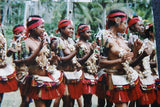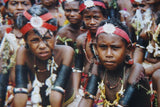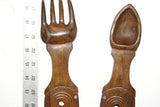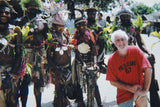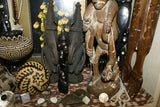SOUTH PACIFIC MELANESIAN ART: DELICATELY HAND CARVED LARGE SERVING TOOLS, USTENSILS WITH INSERTS OF MOTHER OF PEARL, COLLECTED IN THE LATE 1900’S. OCEANIC ART, KULA TRADE, MASSIM REGION, PAPUA NEW GUINEA’S REMOTE ISLANDS.
Melanesian Oceanic Art: Rare item from remote Island, Kula trade, Massim region.
Precious hand crafted, one of a kind, kwila wood, serving set, spoon and fork, all hand carved with much detail by local tribal artist with rudimentary tools, also with enhancing mother of pearl inserts. Beautiful utensils, very decorative collectibles
item 3A3
Hand-carved with intense tribal traditional & detailed motifs and decorated with many inserts of mother of pearl:
Large: 19 1/2" tall x 2 1/2" wide.
The set was collected years ago and was part of our private collection.
The serving instruments of the Trobriands, as their lime spatulas, are among the most beautiful and elegant sculptural carvings in Oceania. They should truly be considered as prized sculptures with amazing etching and carving motifs, a delicate & detailed art form.
Amazingly perfect work considering the basic tools used such as pieces of broken shells, rusted nails from shipwrecks found on the beaches, and sea ray, shark skin or an animal horn or tusk rubbed for days against the surface till all is smooth, among other sanding materials, and to produce a sheen on the wood.
It is very hard to come across such collectibles unless you go there.
These beautiful artistic pieces are prized by collectors.
In these islands which are rarely visited, outside influence is at a minimum. The extremely skilled carvers inspire themselves from what is around them as they have access to nothing else: the natives, birds, fish, pigs, marine turtles, snakes and whatever they see in their dreams such as dragons or mystical figures.
Some of these items have very important meanings as they are used as part of the Kula ring trade system that has existed between the islands for centuries.
The Kula ring is a system of exchange involving annual inter-island visits between trading partners who exchange highly valued shell ornaments and other things during year long sea travels.
In his Argonauts of the Western Pacific (1922), Malinowski analyzed the kula ring, the exchange of shell valuables in a circle around the chain of the islands belonging to PNG . These ornaments were traded from island to island in a counter-clockwise direction:
“A long time ago when the days were longer and the nights shorter lived a hero called Tava who at times took the form of a snake. Tava was known to pass between the villages that are identified as the active . When he was present in a village the people were said to have good fortune and prosper. His location was known only to one woman in each village and she would feed and tend to him. If he felt mistreated or betrayed at any time he would move on to the next island. On his departing the good fortune would also depart with him. He would nevertheless leave each village with a trade.”
This trade ranged from a surplus of pigs and yams in the Trobriands to the fine art or pottery found in the Amphletts. Other places became known for obsidian and Betel nut. It is believed that this myth could be one of the origins of the Kula Ring and the way it functions. Kula is a ritualized trading culture existing in eastern New Guinea which the Trobriands are part of. It is essentially a network of villages joined by a common trade route, known as the Kula which was and still is a life sustaining cultural exchange.
All our collector and rare items come with pages and pages of research about provenance, and with history of the tribes and photos as well, depending on item and whenever possible. When shipping internationally, we group ship multiple purchases to save you money, and find the best rates available. If you have any questions or want to see research conducted on this piece and photos of tribes, let us know.



































